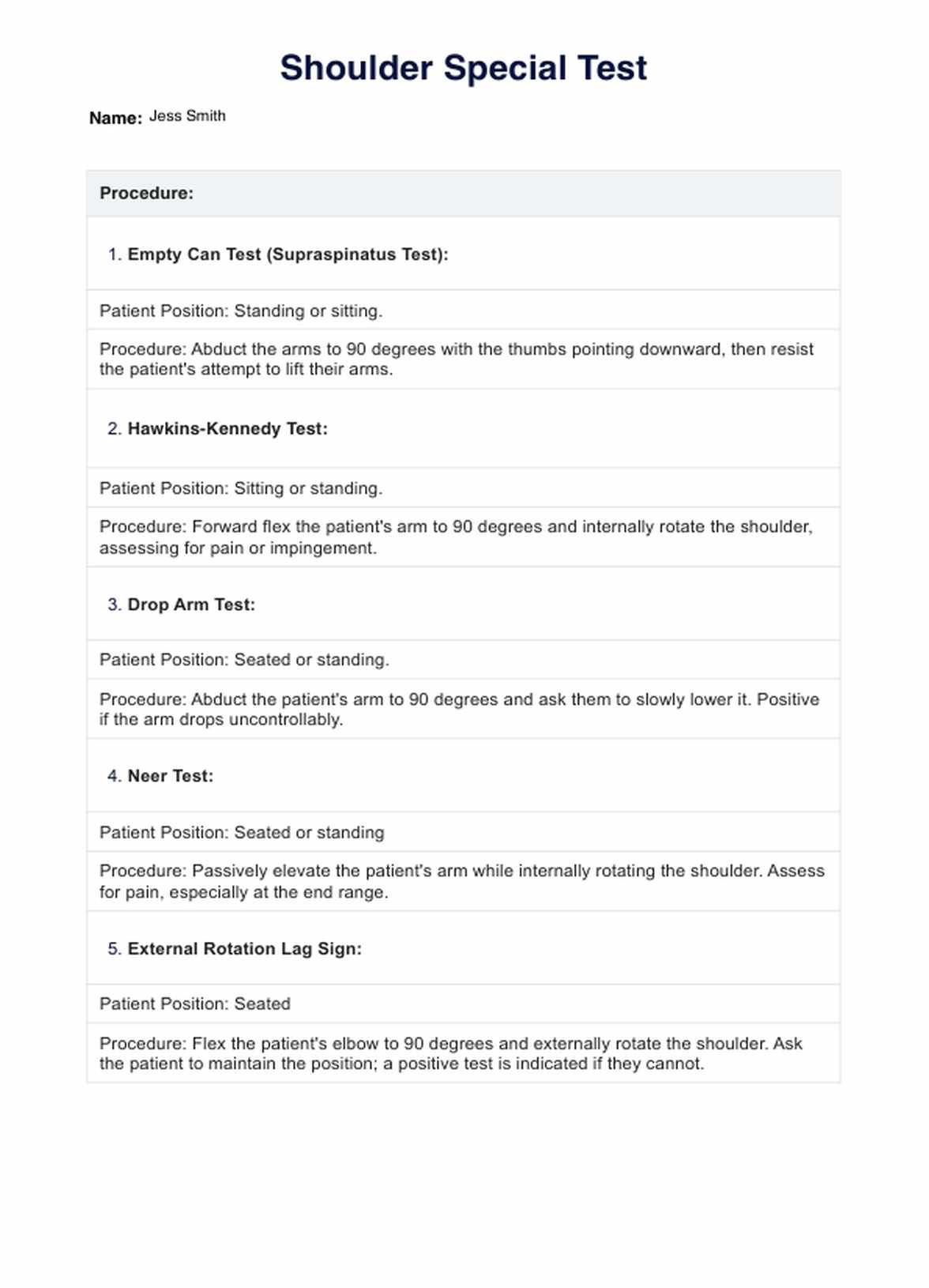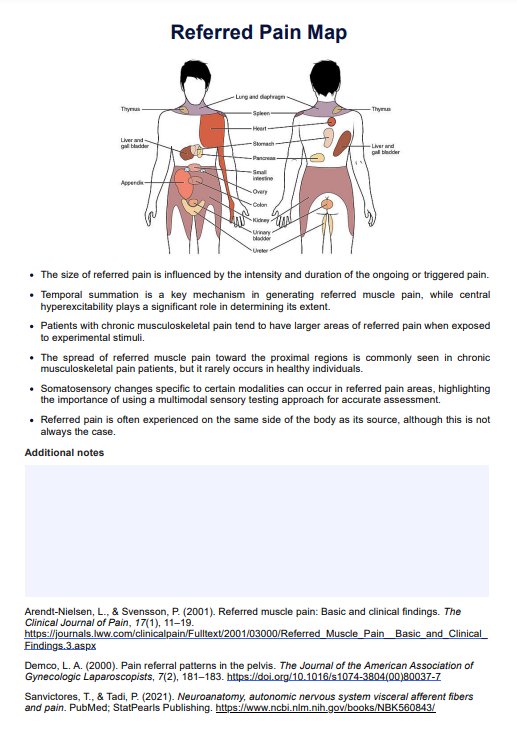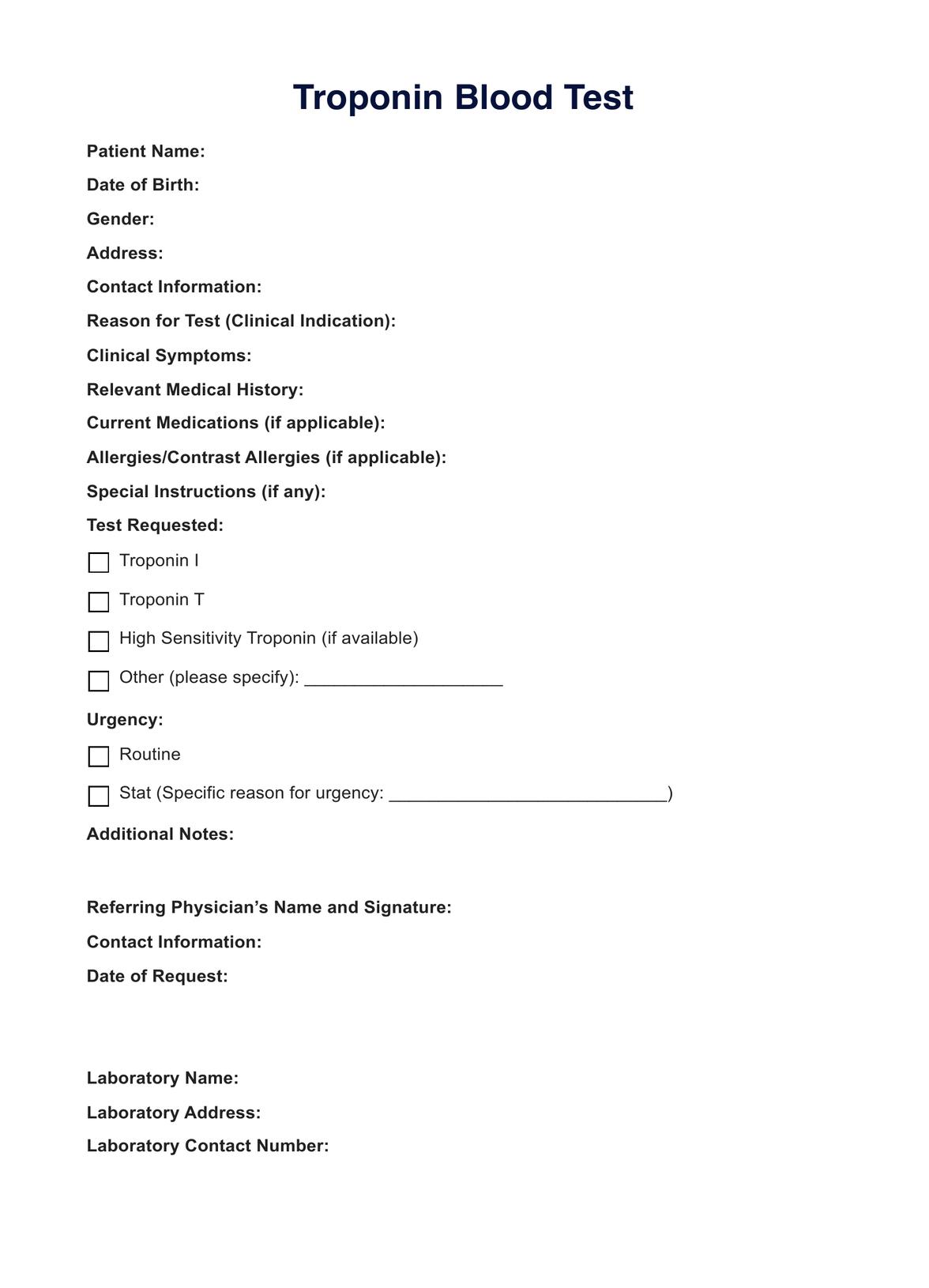Shoulder Special Test
Efficiently assess shoulder health with our Shoulder Special Test to diagnose injuries, evaluate stability, and guide rehabilitation.


What is a Shoulder Special Test?
A full shoulder exam or particular test plays a crucial role in the diagnostic process related to shoulder health, encompassing various clinical examinations that evaluate specific aspects such as rotator cuff tears, shoulder impingement, instability, and pain. These shoulder and arm tests, including the drop arm test, Speed's test, Hawkins-Kennedy test, and others, are fundamental components of a comprehensive shoulder examination. One of the key examinations is the drop arm test, which assesses the ability of the patient to control the arm's descent from an elevated position, indicative of potential rotator cuff pathology.
In addition, the Speed test evaluates pain and weakness associated with resisted shoulder flexion, focusing on the biceps tendon and potential issues like tendinitis. The Hawkins-Kennedy test is designed to identify impingement issues by internally rotating the patient's arm by 90 degrees, potentially revealing pain indicative of shoulder impingement syndrome.
Furthermore, these particular tests contribute to evaluating conditions such as anterior instability through assessments like the apprehension test. The apprehension test involves externally rotating the patient's arm, checking for signs of instability or discomfort, particularly in conditions like anterior instability.
By considering specific tissue structures and utilizing tests such as Yergason's and Neer's tests, clinicians can gain valuable insights into the patient's symptoms, providing a more accurate diagnosis. The Yergason's test focuses on the biceps tendon, assessing for potential pathology, while the Neer test evaluates for impingement by assessing the shoulder's range of motion.
These clinical diagnostic tests are essential components of the shoulder examination toolkit, aiding in identifying issues related to rotator cuff tears, impingement syndromes, and various other shoulder conditions. The results of these tests guide clinicians in formulating effective treatment plans, ensuring targeted and personalized interventions for patients experiencing shoulder-related concerns and pain.
Shoulder Special Test Template
Shoulder Special Test Example
Shoulder pathology & shoulder pain
Shoulder dislocation
Shoulder dislocation occurs when the upper arm bone, or humerus, is forcibly displaced from its normal position in the shoulder socket. This traumatic event can result from injuries or accidents, causing severe pain, swelling, and limited mobility. Immediate medical attention is crucial to address the dislocation, often involving reduction, where the healthcare provider maneuvers the humerus back into its proper place.
Anterior instability
Anterior shoulder instability refers to excessive forward movement of the humeral head within the joint. This condition often leads to a heightened risk of shoulder dislocation, as the humerus can slip out of place more easily.
Individuals with anterior instability may experience pain, a sensation of the shoulder "giving way," and difficulty performing certain movements. In some cases, rehabilitation exercises and surgical interventions may be recommended to stabilize the joint.
Range of motion
Shoulder pathology can significantly impact the range of motion, restricting the ability to move the arm comfortably. Conditions such as rotator cuff injuries, frozen shoulder (adhesive capsulitis), or arthritis can limit flexibility and cause discomfort during everyday activities. Physical therapy and targeted exercises are commonly prescribed to improve the range of motion and alleviate associated pain.
Posterior instability
Posterior instability involves the backward displacement of the humeral head within the shoulder joint. This condition can result from traumatic injuries, repetitive strain, or muscle imbalances. Individuals with posterior instability may experience pain, weakness, and a feeling of instability. Treatment may involve physical therapy to strengthen the surrounding muscles and, in severe cases, surgical intervention.
Inferior laxity
Inferior laxity refers to increased looseness or instability in the lower part of the shoulder joint. This condition can contribute to feelings of shoulder instability and discomfort. Treatment options vary and may include physical therapy to strengthen supporting structures, activity modification, and, in some cases, surgical intervention to address underlying issues.
General inspection
During a general inspection, healthcare providers examine the shoulder for signs of swelling, deformities, or abnormalities. Swelling may indicate inflammation or fluid accumulation, while deformities could suggest dislocations or fractures.
This visual assessment is a crucial initial step in diagnosing shoulder pathologies, guiding further investigations such as imaging studies or physical examinations to determine the underlying cause of shoulder pain.
How does this Shoulder Special Test work?
The shoulder test evaluates various aspects of shoulder function, stability, and potential pathologies. This comprehensive assessment involves a combination of clinical tests designed to analyze specific movements, strength, and the integrity of the shoulder structures. Some key components of this test include:
Range of motion assessment
The healthcare provider assesses the shoulder's flexibility and mobility by guiding the patient through forward flexion, abduction, internal rotation, and external rotation. Limited range of motion may indicate issues like adhesive capsulitis or rotator cuff problems.
Strength testing
The examiner evaluates the strength of specific shoulder muscles using manual resistance or specialized testing devices. Weakness in certain muscle groups may suggest rotator cuff tears, nerve impingements, or other conditions affecting shoulder stability.
Stability checks
Specialized tests, such as the apprehension or relocation tests, assess the shoulder's stability, particularly in suspected instability or dislocation cases. These tests involve specific movements to elicit feelings of apprehension or instability, helping diagnose conditions like shoulder dislocation or anterior instability.
Specific pathology tests
Depending on the suspected issue, specific tests may be performed. For instance, the Neer test and Hawkins-Kennedy test are commonly used to assess for rotator cuff pathology, while the Speed test can evaluate biceps tendon issues.
Palpation and observation
The examiner palpates the shoulder to identify areas of tenderness, swelling, or deformities. Visual inspection during the test helps detect abnormalities in posture, muscle symmetry, or any visible signs of trauma.
Diagnostic imaging
In some cases, diagnostic imaging such as X-rays, MRI, or ultrasound may be employed to visualize internal structures and confirm or further investigate suspected shoulder pathologies.
Interpreting the results of this test
Interpreting the results of a shoulder special test is a crucial aspect of the diagnostic process, providing valuable insights into the patient's musculoskeletal health. Each specific test within the examination targets different aspects, such as range of motion, stability, and potential pathologies.
Positive results indicating abnormalities or limitations may suggest underlying issues like rotator cuff tears, impingement syndrome, or instability. The interpretation involves comparing the patient's performance against established norms and considering the context of their symptoms and medical history.
Healthcare professionals use their expertise to analyze the data, comprehensively understanding the shoulder's condition. This information guides the formulation of an accurate diagnosis and facilitates the development of an effective treatment plan tailored to the patient's specific needs.
Other tests to assess shoulder pain
In addition to the shoulder special tests mentioned earlier, various other diagnostic assessments are crucial in evaluating shoulder pain and identifying specific musculoskeletal issues.
Clinical tests, such as the Hawkins-Kennedy test, Neer test, and Speed's test, focus on different aspects of shoulder function, including impingement, rotator cuff integrity, and anterior instability. These tests involve specific maneuvers, such as internal and external rotations, to provoke symptoms and detect abnormalities.
Diagnostic accuracy is enhanced through the combination of manual muscle testing, functional assessments, and physical examinations, offering a comprehensive evaluation of the range of motion, joint stability, and specific tissue structures.
The examination process may also include a clinical examination, observation, and assessment of the patient's symptoms, allowing healthcare professionals to gather valuable information for an accurate diagnosis and tailored treatment plan. The diverse array of tests, including those evaluating the AC joint, rotator cuff pathology, and anterior instability, contributes to a thorough diagnostic process in understanding the underlying causes of shoulder pain.
Utilizing the drop arm test, shoulder exam, and Yergason's test can significantly enhance your shoulder assessment practice. These tests provide valuable insights into rotator cuff injuries and shoulder stability issues. Additionally, incorporating manual muscle testing into your evaluations helps determine the strength and function of shoulder muscles, which is crucial for a comprehensive assessment. The Hawkins test is another essential tool for diagnosing impingement syndrome, while the supraspinatus test specifically targets the health of the supraspinatus tendon. By integrating these tests into your routine, you can offer more accurate diagnoses and tailored treatment plans for shoulder-related conditions.
Research and evidence
A thorough shoulder examination is crucial for accurately diagnosing issues within this complex area. Numerous tests have been developed to enhance diagnostic precision by focusing on specific components of the shoulder complex. However, confusion often arises regarding the correct execution and interpretation of these tests, many of which are eponymous.
Previous studies and analyses have been completed to clarify tests employed to examine the rotator cuff by presenting them as originally described by their authors, offering a valuable resource for those seeking to refresh their knowledge.
Additionally, physical examination tests of the shoulder play a pivotal role in assessing shoulder complaints. Despite the existence of over 180 such tests in the literature, questions persist regarding their validity and diagnostic usefulness. A recent meta-analysis, adhering to Cochrane guidelines and the PRISMA statement, evaluated the diagnostic odds ratio (DOR) to assess the overall impact of these tests on diagnostic accuracy. The study ranked the performance of individual tests to guide clinicians in their test selection (Gismervik et al., 2017).
Results from the meta-analysis indicated that while the clinical performance of individual tests is limited, pooling different tests for superior labral anterior-posterior (SLAP) lesions demonstrated a statistically significant change in post-test probability, indicating overall validity. Notably, the Supraspinatus test for any full-thickness rotator cuff tear exhibited the highest DOR, emphasizing its diagnostic value. The Compression-Rotation test and Hawkins test also showed significant DOR values for SLAP lesions and impingement syndrome, respectively. The study suggests that clinicians consider tests with the highest pooled DOR and tailor their choices to specific clinical settings, emphasizing the need for future research with randomized designs to enhance the validity of these tests (Tennent et al., 2003).
References
Gismervik, S. Ø., Drogset, J. O., Granviken, F., Rø, M., & Leivseth, G. (2017). Physical examination tests of the shoulder: a systematic review and meta-analysis of diagnostic test performance. BMC Musculoskeletal Disorders, 18(1). https://doi.org/10.1186/s12891-017-1400-0
Tennent, T. D., Beach, W. R., & Meyers, J. F. (2003). A Review of the Special Tests Associated with Shoulder Examination. The American Journal of Sports Medicine, 31(1), 154–160. https://doi.org/10.1177/03635465030310011101
Commonly asked questions
These are specific physical maneuvers performed by your doctor to assess the function and stability of your shoulder joint, tendons, and ligaments. Each test targets different structures of the affected shoulder, helping to identify possible causes of your pain.
While some discomfort is common during the tests, they shouldn't be excruciatingly painful. If you experience significant pain during any test, let your doctor know immediately.
These tests provide valuable clues, but they're not foolproof. Your doctor might need additional imaging tests like X-rays or MRIs to confirm the diagnosis and determine the best treatment course.
















































































































